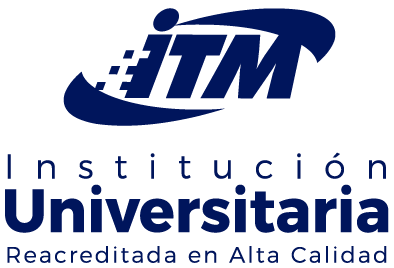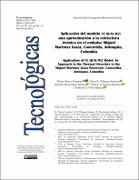Mostrar el registro sencillo del ítem
Aplicación del modelo CE QUAL-W2 : una aproximación a la estructura térmica en el embalse Miguel Martínez Isaza, Concordia, Antioquia, Colombia
| dc.contributor.author | Parra-Cuadros, Mateo | |
| dc.contributor.author | Villegas-Jiménez, Nora E. | |
| dc.contributor.author | Hernández-Atilano , Esnedy | |
| dc.contributor.author | Aguirre-Ramírez, Néstor J. | |
| dc.contributor.author | Vélez-Macías, Fabio de J. | |
| dc.date.accessioned | 2019-10-24T17:35:36Z | |
| dc.date.accessioned | 2019-10-24T18:09:29Z | |
| dc.date.available | 2019-10-24T17:35:36Z | |
| dc.date.available | 2019-10-24T18:09:29Z | |
| dc.date.issued | 2019-09-20 | |
| dc.identifier | https://revistas.itm.edu.co/index.php/tecnologicas/article/view/1222 | |
| dc.identifier | 10.22430/22565337.1222 | |
| dc.identifier.uri | http://hdl.handle.net/20.500.12622/1417 | |
| dc.description.abstract | La modelación de la temperatura contribuye a la gestión de embalses, ya que es posible crear escenarios con diferentes condiciones para predecir su respuesta ante los cambios climáticos y los procesos de mezcla. Con este trabajo se busca aportar elementos de análisis del funcionamiento e identificación de los forzantes que dominan la dinámica térmica de un embalse tropical de montaña. Se registró la temperatura y el nivel de agua en tres sitios del embalse durante tres muestreos. Además, se midieron los caudales de entrada y salida al embalse y se analizaron los registros climáticos históricos. Con esta información se construyeron los archivos de entrada del modelo bidimensional CE QUAL-W2, para simular cuatro escenarios climáticos (seco, lluvia, transición y el fenómeno El Niño). De las afluencias se evidenció que la quebrada Santa Mónica en términos hidrodinámicos ejerce su efecto hasta el sitio de captación; de otro lado, la quebrada la Nitrera presenta recirculaciones verticales que aumentan el tiempo de residencia lo que tiene consecuencias en la calidad del agua para este sector del embalse. Los resultados de este ejercicio preliminar de modelación indican que el comportamiento térmico del embalse responde de manera diferenciada según el escenario climático y la magnitud de las extracciones. Durante el fenómeno El Niño y ante un incremento del agua captada, el embalse disminuye el nivel de agua en cerca de un metro y aumenta su temperatura alrededor de 3°C en la zona central del embalse. Ante la tendencia de crecimiento del municipio, se espera mayores demandas de agua que deberán ser suplidas por el embalse, por lo que toman importancia las herramientas de modelación que apoyen la gestión ambiental y reduzcan el riesgo al desabastecimiento ante la vulnerabilidad al cambio de climático. | spa |
| dc.format.mimetype | application/pdf | |
| dc.language.iso | spa | |
| dc.publisher | Instituto Tecnológico Metropolitano (ITM) | spa |
| dc.relation | https://revistas.itm.edu.co/index.php/tecnologicas/article/view/1222/1333 | |
| dc.rights | Copyright (c) 2019 TecnoLógicas | spa |
| dc.rights | https://creativecommons.org/licenses/by-nc-sa/4.0 | spa |
| dc.source | 2256-5337 | |
| dc.source | 0123-7799 | |
| dc.source | TecnoLógicas; Vol 22 No 46 (2019); 99-113 | eng |
| dc.source | TecnoLógicas; Vol. 22 Núm. 46 (2019); 99-113 | spa |
| dc.subject | CE-QUAL-W2 | spa |
| dc.subject | Hidrodinámica | spa |
| dc.subject | embalse | spa |
| dc.subject | conservación del agua | spa |
| dc.subject | cambio climático | spa |
| dc.subject | análisis estadístico | spa |
| dc.title | Aplicación del modelo CE QUAL-W2 : una aproximación a la estructura térmica en el embalse Miguel Martínez Isaza, Concordia, Antioquia, Colombia | spa |
| dc.title.alternative | Application of CE QUAL-W2 Model: An Approach to the Thermal Structure in the Miguel Martínez Isaza reservoir, Concordia, Antioquia, Colombia | eng |
| dc.subject.keywords | CE-QUAL-W2 | eng |
| dc.subject.keywords | hydrodynamic | eng |
| dc.subject.keywords | water management | eng |
| dc.subject.keywords | reservoir | eng |
| dc.subject.keywords | climate change | eng |
| dc.subject.keywords | statistical analysis | eng |
| dc.type | info:eu-repo/semantics/article | |
| dc.type | info:eu-repo/semantics/publishedVersion | |
| dc.type | Research Papers | eng |
| dc.type | Artículos de investigación | spa |
| dc.relation.ispartofjournal | TecnoLógicas | |
| dc.description.abstractenglish | Hydrodynamic modelling of temperature is a tool that contributes to the management of reservoirs because it is possible to create scenarios with different conditions to predict the behavior facing the meteorological changes and the mixing processes. This work seeks to contribute elements of analysis to the functioning and identification of the external factors that dominate the thermal dynamics of a tropical reservoir of mountain. The temperature and the water level were registered in three places of the reservoir, during three campaigns of sampling. In addition, we measured the inflows and outflows to the reservoir and analyzed the climatic historical records. With this information the two-dimensional model CE QUAL-W2 archives was build, in order to simulate 3 climatic periods (dry, transition and wet) and one where El Niño is included. It is clearly demonstrated that Santa Mónica creek has a greater influence in the water extraction. The external factors like the increase of the water extraction and the climatic scenarios influence the temperature and availability of the reservoir, being El Niño scenario the most critical, where the reservoir approximately increases its temperature 3°C and the level of the water diminishes a meter. The reservoir is increasingly susceptible to the shortage of supplies and the decrease of quality in the scenes of drought with the increase of the resource demand. The model is a useful management tool of the reservoir for the future scenarios of climate change. | eng |
| dc.rights.accessrights | info:eu-repo/semantics/openAccess | |
| dc.type.coar | http://purl.org/coar/resource_type/c_6501 |
Ficheros en el ítem
Este ítem aparece en la(s) siguiente(s) colección(ones)
-
Vol 22 No 46 (2019) [15]


